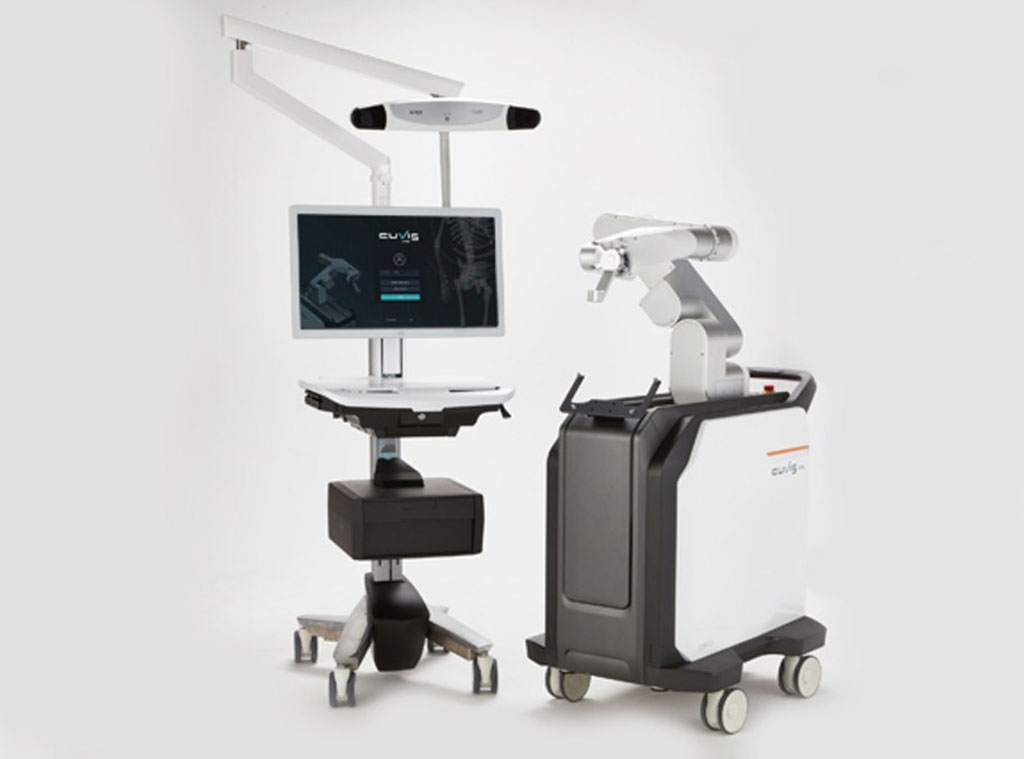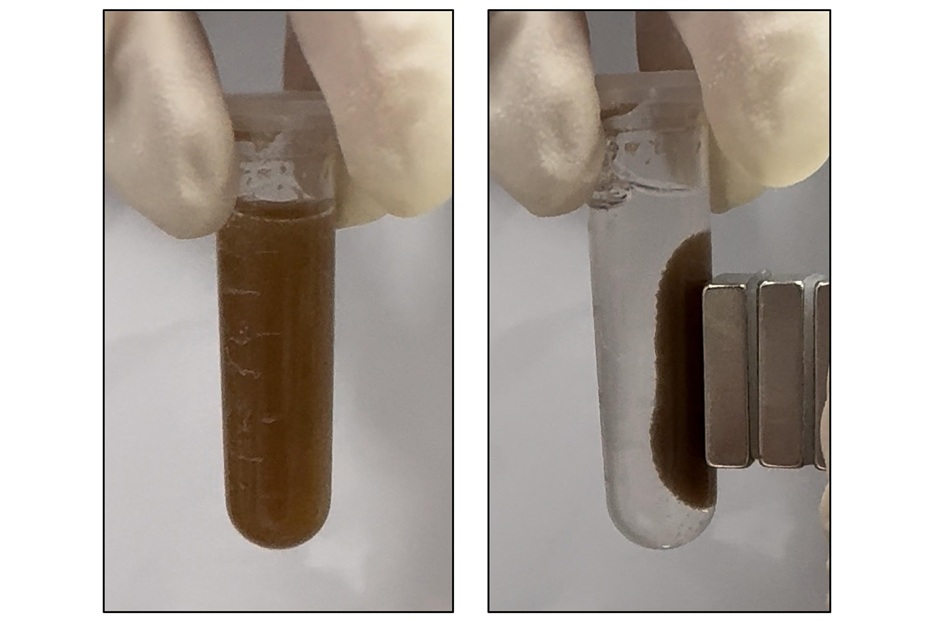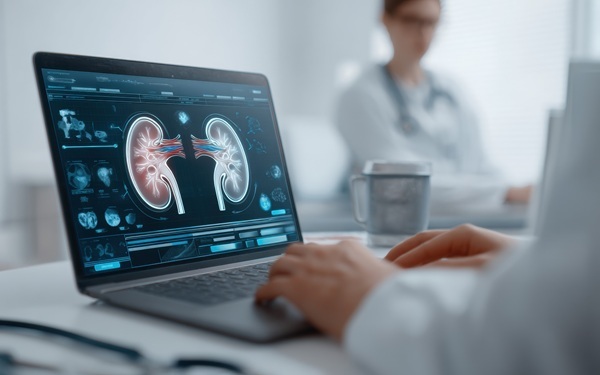Robotic System Simplifies the Spinal Surgery Process
|
By HospiMedica International staff writers Posted on 02 Jun 2021 |

Image: The CUVIS-Spine spinal surgery robot main console (L) and robotic arm (R) (Photo courtesy of Curexo)
A highly accurate one-step surgical tool with a real-time tracking sensor provides practitioners with fast, simple, and precise pedicle screw insertion.
The Curexo (Seoul, South Korea) CUVIS-Spine is a next-gen spinal surgery robot that guides the insertion of a pedicle screw according to the surgery plan. The system includes uses a high precision robot arm and wireless, one-step navigation based on a real-time GPS-like sensor that provide precise, safe, and faster surgery, when compared to traditional manual placement. It also minimizes X-ray radiation exposure of both patients and medical staff, as only two slices (AP and LL) are needed for plan the pedicle screws entry point, target point, and route.
Both two-dimensional X-ray filming (via a C-arm) and three -dimensional filming (with an O-arm) are available, expanding clinician’s options. The wireless one-step navigation and robot arms allow multiple steps, such as needling, K-wire manipulation, dilation, and tapping) to be performed using just one tool, reducing surgery duration greatly. In order to prevents surgical instruments from skiving, an optical tracking system (OTS) provides accurate data on the lateral force affecting the arm and pedicle screw in real-time.
“The spinal surgery robot 'CUVIS-spine' that we have developed and manufactured with our technology has acquired FDA (US)'s licensing. This is the 3rd license that we have acquired, followed by Korea and Europe, and now we can sell our solution in all countries including the US which is the biggest medical market." He also said that "CUREXO plans to focus on our medical robots sales, including 'CUVIS-joint', 'CUVIS-spine' and 'Morning Walk' to not only the Korean market but also to advanced medical markets such as the US and Europe."
“CUVIS-Spine had successfully carried out the insertion of pedicle screws on a patient with spinal stenosis and degenerative spondylolisthesis,” said Jae-Joon Lee, CEO of Curexo, following the first successful spinal robotic surgery at Severance Hospital (Sinchon, South Korea). “After the surgery, image examinations had proven the fixation of the screws as originally planned, and the patient was able to leave the hospital on the fifth day with improvements.”
“I expect that Korean robots will be able to enter the market by accumulating track records and creating clinical evidence in the field of spinal surgical robots, which is expanding globally," said Seong Yi, MD, of the department of neurosurgery at Severance Hospital, who participated in the development of CUVIS-Spine. “Clinical data of spinal surgical robots, including safety, validity, and radiation safety level will contribute to the development and globalization of the domestic surgical robot industry.”
Pedicle screws provide a means of gripping a spinal segment. The screws themselves do not fixate the spinal segment, but act as firm anchor points that can then be connected with a rod. The screws are placed at two or three consecutive spine segments and then a short rod is used to connect the screws; this construct prevents motion at the segments that are being fused. After the bone graft grows, the screws and rods are no longer needed for stability and may be safely removed. However, most surgeons do not recommend removal unless the pedicle screws cause discomfort for the patient.
Related Links:
Curexo
The Curexo (Seoul, South Korea) CUVIS-Spine is a next-gen spinal surgery robot that guides the insertion of a pedicle screw according to the surgery plan. The system includes uses a high precision robot arm and wireless, one-step navigation based on a real-time GPS-like sensor that provide precise, safe, and faster surgery, when compared to traditional manual placement. It also minimizes X-ray radiation exposure of both patients and medical staff, as only two slices (AP and LL) are needed for plan the pedicle screws entry point, target point, and route.
Both two-dimensional X-ray filming (via a C-arm) and three -dimensional filming (with an O-arm) are available, expanding clinician’s options. The wireless one-step navigation and robot arms allow multiple steps, such as needling, K-wire manipulation, dilation, and tapping) to be performed using just one tool, reducing surgery duration greatly. In order to prevents surgical instruments from skiving, an optical tracking system (OTS) provides accurate data on the lateral force affecting the arm and pedicle screw in real-time.
“The spinal surgery robot 'CUVIS-spine' that we have developed and manufactured with our technology has acquired FDA (US)'s licensing. This is the 3rd license that we have acquired, followed by Korea and Europe, and now we can sell our solution in all countries including the US which is the biggest medical market." He also said that "CUREXO plans to focus on our medical robots sales, including 'CUVIS-joint', 'CUVIS-spine' and 'Morning Walk' to not only the Korean market but also to advanced medical markets such as the US and Europe."
“CUVIS-Spine had successfully carried out the insertion of pedicle screws on a patient with spinal stenosis and degenerative spondylolisthesis,” said Jae-Joon Lee, CEO of Curexo, following the first successful spinal robotic surgery at Severance Hospital (Sinchon, South Korea). “After the surgery, image examinations had proven the fixation of the screws as originally planned, and the patient was able to leave the hospital on the fifth day with improvements.”
“I expect that Korean robots will be able to enter the market by accumulating track records and creating clinical evidence in the field of spinal surgical robots, which is expanding globally," said Seong Yi, MD, of the department of neurosurgery at Severance Hospital, who participated in the development of CUVIS-Spine. “Clinical data of spinal surgical robots, including safety, validity, and radiation safety level will contribute to the development and globalization of the domestic surgical robot industry.”
Pedicle screws provide a means of gripping a spinal segment. The screws themselves do not fixate the spinal segment, but act as firm anchor points that can then be connected with a rod. The screws are placed at two or three consecutive spine segments and then a short rod is used to connect the screws; this construct prevents motion at the segments that are being fused. After the bone graft grows, the screws and rods are no longer needed for stability and may be safely removed. However, most surgeons do not recommend removal unless the pedicle screws cause discomfort for the patient.
Related Links:
Curexo
Latest Surgical Techniques News
- Novel Endoscopy Technique Provides Access to Deep Lung Tumors
- New Study Findings Could Halve Number of Stent Procedures
- Breakthrough Surgical Device Redefines Hip Arthroscopy
- Automated System Enables Real-Time "Molecular Pathology" During Cancer Surgery
- Groundbreaking Procedure Combines New Treatments for Liver Tumors
- Ablation Reduces Stroke Risk Associated with Atrial Fibrillation
- Optical Tracking Method Identifies Target Areas in Robot-Assisted Neurosurgery
- General Anesthesia Improves Post-Surgery Outcomes for Acute Stroke Patients
- Drug-Coated Balloons Can Replace Stents Even in Larger Coronary Arteries
- Magnetic Kidney Stone Retrieval Device Outperforms Ureteroscopic Laser Lithotripsy
- Absorbable Skull Device Could Replace Traditional Metal Implants Used After Brain Surgery
- Magic Silicone Liquid Powered Robots Perform MIS in Narrow Cavities
- 'Lab-on-a-Scalpel' Provides Real-Time Surgical Insights for POC Diagnostics in OR
- Biodegradable Brain Implant Prevents Glioblastoma Recurrence
- Tiny 3D Printer Reconstructs Tissues During Vocal Cord Surgery
- Minimally Invasive Procedure for Aortic Valve Disease Has Similar Outcomes as Surgery
Channels
Critical Care
view channel
AI Helps Optimize Therapy Selection and Dosing for Septic Shock
Septic shock is a life-threatening complication of sepsis and remains a leading cause of hospital deaths worldwide. Patients experience dangerously low blood pressure that can rapidly lead to organ failure,... Read more
Glowing Bacteria ‘Pills’ for Detecting Gut Diseases Could Eliminate Colonoscopies
Diagnosing gastrointestinal diseases such as colitis and colorectal cancer often relies on colonoscopy, an invasive procedure that many patients avoid despite ongoing symptoms like bleeding, cramping, and diarrhoea.... Read more
Skin-Permeable Polymer Patch Delivers Insulin Non-Invasively Through Skin
Managing diabetes requires regular insulin delivery, but injections remain invasive and burdensome for patients. While transdermal drug delivery works well for small molecules, the skin acts as a strong... Read more
Nanogel Technology Almost 100% Effective in Destroying Drug-Resistant Bacteria Within Hours
Antibiotic resistance is one of the most serious global health threats, driven by bacteria that evade treatment and form protective biofilms that shield them from drugs. Pathogens such as Pseudomonas aeruginosa,... Read morePatient Care
view channel
Revolutionary Automatic IV-Line Flushing Device to Enhance Infusion Care
More than 80% of in-hospital patients receive intravenous (IV) therapy. Every dose of IV medicine delivered in a small volume (<250 mL) infusion bag should be followed by subsequent flushing to ensure... Read more
VR Training Tool Combats Contamination of Portable Medical Equipment
Healthcare-associated infections (HAIs) impact one in every 31 patients, cause nearly 100,000 deaths each year, and cost USD 28.4 billion in direct medical expenses. Notably, up to 75% of these infections... Read more
Portable Biosensor Platform to Reduce Hospital-Acquired Infections
Approximately 4 million patients in the European Union acquire healthcare-associated infections (HAIs) or nosocomial infections each year, with around 37,000 deaths directly resulting from these infections,... Read moreFirst-Of-Its-Kind Portable Germicidal Light Technology Disinfects High-Touch Clinical Surfaces in Seconds
Reducing healthcare-acquired infections (HAIs) remains a pressing issue within global healthcare systems. In the United States alone, 1.7 million patients contract HAIs annually, leading to approximately... Read moreHealth IT
view channel
EMR-Based Tool Predicts Graft Failure After Kidney Transplant
Kidney transplantation offers patients with end-stage kidney disease longer survival and better quality of life than dialysis, yet graft failure remains a major challenge. Although a successful transplant... Read more
Printable Molecule-Selective Nanoparticles Enable Mass Production of Wearable Biosensors
The future of medicine is likely to focus on the personalization of healthcare—understanding exactly what an individual requires and delivering the appropriate combination of nutrients, metabolites, and... Read moreBusiness
view channel
Philips and Masimo Partner to Advance Patient Monitoring Measurement Technologies
Royal Philips (Amsterdam, Netherlands) and Masimo (Irvine, California, USA) have renewed their multi-year strategic collaboration, combining Philips’ expertise in patient monitoring with Masimo’s noninvasive... Read more
B. Braun Acquires Digital Microsurgery Company True Digital Surgery
The high-end microsurgery market in neurosurgery, spine, and ENT is undergoing a significant transformation. Traditional analog microscopes are giving way to digital exoscopes, which provide improved visualization,... Read more
CMEF 2025 to Promote Holistic and High-Quality Development of Medical and Health Industry
The 92nd China International Medical Equipment Fair (CMEF 2025) Autumn Exhibition is scheduled to be held from September 26 to 29 at the China Import and Export Fair Complex (Canton Fair Complex) in Guangzhou.... Read more













